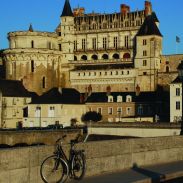Loire Valley Cycling Holidays
Flamboyant châteaux, rolling vineyards, lazy rivers, relaxing cycling.
The Loire Valley is home to some of France’s finest cultural treasures: medieval fortresses,
palatial hunting lodges, half-timbered streets, enchanting forests, impressive cathedrals
and troglodyte dwellings.
We can’t pinpoint which treasure you’ll find the most appealing, but we’ve tried to give a little background to a few of the favourite places included in our Loire Valley Cycling Holidays..
Find out more about cycling tours in France including the Loire Valley
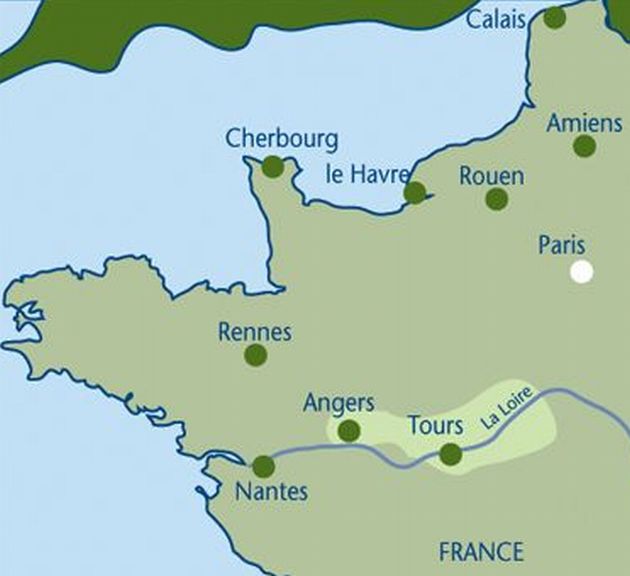
Bustling with riverside cafes, fascinating for its connections with Leonardo da Vinci at the Clos Lucé, and simply stunning in terms of castle appeal – Amboise is a great Loire Valley favourite. The Renaissance château sits defensively, up high above the river, built on the old foundations of a fortress. It is only about a fifth of its original size now and sparsely furnished, so it takes a bit of imagination to get a feel for its significance and its past. The views are stunning though and the terrace garden often home to a pleasant breeze. Leonardo da Vinci’s remains now lie in the Chapel de Saint Hubert in the grounds of the castle.
Angers
The old capital of Anjou is renowned for its massive feudal castle, complete with no less than 17 ‘stripey’ round towers and royal apartments around a circular internal courtyard. It dates from 1230 and owes its stripes to the use of tufa stone for decoration only. The earthworks are now home to beautiful formal gardens and there is a pleasant renaissance style garden within the castle walls. The tapestry museum with its 140m long Apocalypse series of tapestries is not to be missed. Angers cathedral, dedicated to St. Maurice, has the largest nave in France and magnificent medieval stained glass. The town also has many architectural treasures from town houses to the remains of a former bishop’s palace and one of the finest ‘hospices’ of the middle ages.
Azay-le-Rideau
This little gem of a castle seems to float on the River Indre. Small, but a great favourite all round, it does tend to be busier than many of the other château nearby. Symmetrical and Italianate, it is a wonderful example of Renaissance architecture and its grand staircase reveals the real craftsmanship of the era too. Unlike many château, rooms are furnished and represent a number
of period styles.
back to map
Beaugency
An impressive 14th C. 26 arch bridge leads over the River Loire to the heart of this picturesque medieval town which has preserved much of its rich past. Clustered around a series of squares, key landmarks include the massive 12th C. ‘Caesar’ tower and the Romanesque abbey church of Notre-Dame, scene of the marriage annulment of Louis VII and Eleanor of Aquitaine in 1152. The
15th C. Château Dunois was built by Jean, Bastard of Orléans and comrade of French heroine, Joan of Arc, who liberated Beaugency from English troops in 1429. Her statue stands proudly in the ‘Place St-Firmin’.
Beauregard
On the site of a former hunting lodge in the park of the illustrious Chambord, the château is especially renowned for its outstanding collection of 327 portraits which literally line the walls of the gallery whose floor is paved in delft tiles – a true hall of fame and an excellent way to get to grips with French history from the 14th to 17th C. The château has parkland and formal gardens with ‘rooms’ boxed off by smart hedging.
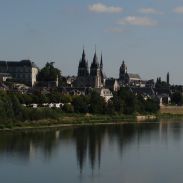 Blois
Blois
Brim-full of historic buildings, it’s hard to escape the charming streets of Blois, let alone its magnificent château even for a quick visit to the Houdini Museum. As châteaux go, it has one of the few which can really reveal the evolution of French architecture from the Middle Ages to the 17th C. It also boasts one amazing
feature – the great open staircase with its sculpted balconies set in an octagonal tower giving on to the courtyard. The salamanders and monograms of Francois I are truly in evidence here. Inside, renovation work has returned former splendour through restored floor tiles and colourful walls.
Brézé
Built between the 11th and 16th C. the Renaissance-style Château de Brézé is one of the most intriguing in the Loire
Valley – a ‘castle on top of a castle’. Visitors can descend into the underground fortress of the Lords of Brézé, an incredible defensive system comprising tunnels, chambers and troglodyte dwellings carved out of the living rock by hand over hundreds of years. Here, in times gone by, precious warhorses, wines and unfortunate prisoners were housed. One of the highlights is the largest underground bakery in France.
Candes-St-Martin
Situated at the point where the River Vienne flows into the mighty Loire, the hillside spot of Candes-St-Martin has buildings of grey slate and tufa (limestone) and is one of France’s most beautiful villages. The 12th C. fortified Collegiate Church of Saint-Martin is noted for its façade adorned with numerous statues and stained glass telling the story of Saint Martin who came here in the 4th C.
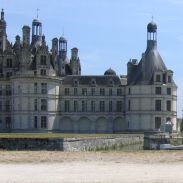 Chambord
Chambord
Francois I’s rather extravagant hunting lodge contains over
400 rooms, some 365 fireplaces and 84 staircases. Best to allow quite a bit of time to visit then! It is over-powering perhaps, but breathtaking from the outside (climb up to the roof tops and you will see that the extravagance doesn’t even stop on the pinnacles). There are hectares and hectares of grounds to explore by bike on marked routes. Although only a few rooms are decorated these are unrivalled, impressive even if not furnished, simply as a result of their size. The internal double spiral staircase is said to have been influenced by Leonardo da Vinci.
Chaumont-sur-Loire
Squat, smart and solid, Chaumont is built on the site of a former fortress. It only has three sides as the one facing the river was moved in the 16th C. apparently to improve the river views. The château has links with Catherine de Medici and Diane de Poitiers, who it is said, was forced to give up Chenonceau to live here after the death of her lover, Henri II.
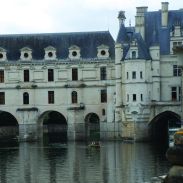 Chenonceau
Chenonceau
Great for a ‘son et lumière’ experience, the refined gardens and bridge-like château is both personal somehow – and populated! It oozes history and intrigue, dominated by stories of husbands and lovers. Framed by Diane de Poitier’s garden to the left and Catherine de Medici’s garden to the right, sits a 15th C. cylindrical keep, followed by the 16th C. château with its five arches which span the river and support the two storeys, including the long gallery. Inside rooms are furnished and the kitchens and chapel are also worth a visit.
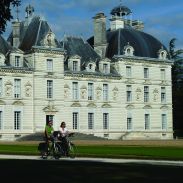 Cheverny
Cheverny
Arguably the only classical château left in the Loire Valley – Cheverny seems to have escaped the Renaissance and sits shoulders back and head high, proudly symmetrical, devoid of the regular array of turrets and domes, somehow compact and comforting. The property is impressively decorated with lavish furnishings, tapestries and wood panelling. During WWII, the Mona Lisa took up residence in the orangery here, along with many other priceless artefacts from the Louvre in need of
safe-keeping. The château has great ties with the hunt, and
100 hounds are kept at the kennels near the main entrance.
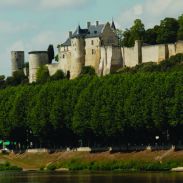 Chinon
Chinon
The ancient château has links with Henry II, one of the English Plantagenet kings whose son, Richard the Lionheart was born here. The castle reaches some 400m along the steep promontory and is actually the remains of three separate fortresses dating from 12-15th C. The old town is very picturesque with tall gables and half-timbered houses lining narrow winding streets as it stretches out along the banks of the River Vienne. Along the streets below the castle walls are Troglodyte dwellings, many used by wine merchants.
Chitenay
This delightful rural village has a history dating back to the 12th C. Physicist, mathematician and inventor Denis Papin was born here in 1647. He is noted for his work on the steam engine. Set close to the verdant scenery of the Sologne Forest, Chitenay provides a perfect location for our single centre Loire Valley holidays with day rides to some of the most spectacular châteaux in the region.
Fontevraud L’Abbaye
Established in 1099 as both a nunnery and monastery, this is one of the largest monastic cities in Europe. Vast, intact and haunting, Fontevraud L’Abbaye has strong historical links with the great and good of the Plantagenet dynasty – King Henry II of England’s widow Eleanor of Aquitaine was a nun here and their tombstone effigies, along with their son King Richard I (of Lionheart fame) can be seen within the spacious abbey church. Forced to shut by the French Revolution, the complex later became a prison.
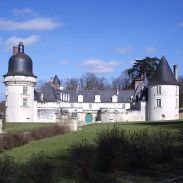
Gué-Péan
Cute and slightly more curvaceous than most châteaux, this is a charming little find set in a wooded area around a small courtyard with central pond. The simple chapel has some interesting WWI graffiti and USA connections. The rooms are adorned more with general local artefacts than pieces of particular significance to the property.
Langeais
A fortress-like 15th C. château with complete towers, turrets and working drawbridge is set dramatically in the centre of this small hillside town. Built by Charles VII’s son, Louis XI, it became the home of the Count of Dunois. In 1491 this was the scene of the marriage of Charles VIII and Duchess Anne of Brittany, the event prompting the permanent union of Brittany and France. Banker, Jacques Siegfried, purchased the property in 1886 and spent the next 20 years restoring and recreating a 15th C. residence, richly decorated with tapestries, furniture and objects’ d’art. Within the gardens are the traces of an earlier stone keep dating from the end of the 10th C.
Meung-sur-Loire
Attractive streets, charming houses and an impressive fortified church make up this historic town which was the scene of a great battle between the French and English in 1429. Led by Joan of Arc, the French heroine stayed at the sprawling Château de Meung which dates from the 12th C. A former residence of the bishops of Orléans, visitors can explore this ancient building with its drawing rooms, chapel, underground passages and gardens. The town provided inspiration for the popular Maigret detective novels by Georges Simenon, whilst Alexander Dumas had fictional d’Artagnan (The Three Musketeers) flourishing his sword at the Comte de Rochefort here.
Montlouis-sur-Loire
Just to the south of this town is the Château de la Bordelaisière originally constructed in the 16th C. by François I for his mistress. Later in ruins, a massive reconstruction was undertaken in the 19th C. The château is now a luxury hotel set in beautiful parkland, famous for its award-winning gardens displaying fruits, herbs, flowers and vegetables (including 650 tomato varieties).
Montpoupon
The famous château here huddles right up close to the road. All turrets and towers, it’s well worth stopping to view it from a little further away. With strong hunt connections there is plenty to attract those with an interest in horses. Though nowhere near as grand as its neighbours, the place does feel strangely lived in and the hunting museum and rooms on display do have a different sort of charm to other châteaux in the Loire.
Montreuil Bellay
Set amongst vineyards and wheat fields on the banks of the River Thouet, this is one of the last fortified towns in the area to retain most of its medieval walls and gateways. Quaint narrow streets are lined with magnificent old houses. The mighty château dates from the 13-15th C. with its ramparts and 13 interlocking towers.
A tour takes you through the medieval kitchen, carved dining room and vaulted cellars which have been used for wine-making. During the Great War, the building became a makeshift hospital with almost 1,200 soldiers treated here. Outside are ancient trees, sweet-smelling roses and the 15th C. Collegiate Church.
Montrichard
Overlooked by the ruins of its massive fortress keep, this bustling and picturesque market town is situated alongside the River Cher. Here, a wander in the historic streets will take you past numerous medieval and renaissance buildings. In 1476, the Romanesque Church of St. Croix was the scene of the marriage of the Duke of Orléans (the future Louis XII) to Jeanne de France, daughter of Louis XI. Local caves provide storage for wine and excellent conditions for the cultivation of mushrooms.
Montsoreau
Said to be one of the prettiest villages in France with its slated limestone white houses and flower displays. A stroll alongside the River Loire will take you past the fine 15th C. château, rising grandly out of the waters. It was made famous by the Alexandre Dumas novel ‘La Dame de Montsoreau’. Cut into the cliffs nearby are the old troglodyte homes of farmers and fishermen, where the limestone was extracted for building stone. Some of these caves are now used to cultivate mushrooms.
back to map
Orléans
Set alongside the River Loire, Orléans is famous for its connections with French heroine Joan of Arc who freed the city from a siege by English troops in 1429. Visit the reconstruction of the half-timbered house where she stayed and see the statues of the ‘Maid of Orléans’ in the ‘Place du Martroi’ and outside the Hotel Groslot. Once the City Hall, the Hotel Groslot is noted for its attractive rooms, renaissance furniture and pretty gardens. A walk along the ‘Grand rue Jeanne d’Arc’ will take you past chic boutiques and patisseries full of tempting treats to the magnificent Neo-Gothic Cathedral of St-Croix, where beautiful stained glass windows depict the life of Joan of Arc. Well worth a visit too is the Musée des Beaux-Arts with its important collections of
paintings and sculpture.
Saumur
Lovely old town with wine cellars and an imposing bulk of a château with four corner towers which though stocky and solid always seems somewhat graceful, towering above the Loire. Certainly, the place for stunning views over the valley. Originally built in the 14th C. it became home to the Duke d’Anjou, a governor’s house and jail. Today the royal apartments are two museums: one dedicated to fine art, the other to the horse.
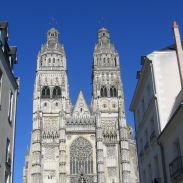 Tours
Tours
The capital of Touraine and the largest city in the Loire Valley, Tours has two main attractions: the impressive gothic St. Gatien cathedral with its rare 13th C. stained glass and charming later Psallette cloister; and the medieval quarter around the Place Plumereau with its timber and brick houses. The fine art museum is situated in the archbishop’s palace complete with a suite of rooms decorated with panelling and silk hangings
and a worthy collection of works by grand masters such as Rembrandt, Boucher and Rubens.
Villandry
Built in the 16th C. by François I’s finance minster, Jean le Breton, this is one of the most visited châteaux in France with its moat, arcaded galleries and steep slate roofs. In the early 1800’s it became the property of Joseph Bonaparte, brother of Napoleon. Villandry is renowned today for its spectacular Renaissance gardens – from the box hedges and intricate patterns of the Love Garden to the geometrical chequerboard of colours in the Kitchen Garden where the jade green of carrot plants contrasts with the red leaves of beetroot. There’s an adjacent garden full of herbs and aromatic plants once cultivated for cooking and medicinal purposes, whilst a ‘cloister’ of trees surrounds the glimmering lake of the Water Garden.

